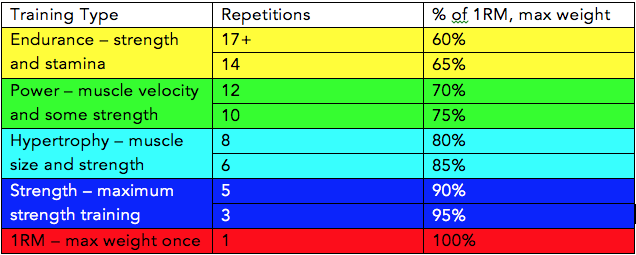STRENGTH! WHAT IS IT GOOD FOR?
Training for strength
Strength training uses the most weight with the least amount of repetitions with long rest periods in-between. Aiming for the ability to lift large amounts of weight for less time. Following the process of task-specific training, this is most effective for people who are trying to increase their overall load to be moved.
Training for Muscle Hypertrophy (growth)
Hypertrophy refers to muscle size as well as strength, you may see this in body-building where they utilise lighter weights, more repetitions and less time resting for particular muscle groups. Muscles require metabolic stress to increase in size, thus as a result of lactate acid build up and micro tears, the muscle then uses its repair process to rebuild and grow larger. This principle is best used for those beginning any exercise program as this utilises the aims of both muscle strength and movement, combining components of strength and endurance principles.
Training for Power
Power training involves using reasonably lighter weights and longer rest periods whilst the aim of the movement is to encourage speed. Power generally refers to the ability to move at high speeds. Power also includes the use of physics where force equals mass times acceleration and power training aims to practicing the acceleration part of the lift. Power principles are usually seen in athletes or powerlifting where weight is increased but require a high speed to move a certain weight. Power based exercises can also be found in HIIT workouts where explosive movements are completed with reduced rest.
Training for Muscular endurance
Endurance training requires more repetitions to ensure muscle functioning can last longer, usually with lighter weights. Rest is usually less for this principle as endurance is suggestive for long durations with little recovery. Endurance based programs for created for marathon runners, or for the everyday person to be able to withstand loading for an extended amount of time.
Which one is for you?
Consider your goal – what do you want to achieve out of your exercise program?
Consider your day-to-day activities – what do you do each day that requires a specific exercise program relative to your daily routine?
Consider what you have done previously – exercise, work and medical history can all have an impact on the physiological systems used within each of the above principles.
A training program is a variety of structured exercises using the principle FITT will guide you towards achieving your goals better.
• Frequency
• How many times a week for an activity?
• For sedentary individuals, start with 2-3 days/week of aerobic exercise and build up to 5 days/week. Build an exercise regime suited to your lifestyle.
• Intensity
• How hard to exert?
• Someone new to exercise should start at a low intensity, but health changes occur at a moderate exercise intensity
• Type
• Which type of activity should you do?
• Should be enjoyable, affordable, and achievable
• Time
• How long in minutes
• This does not include the warm up or cool down.
• 10 min bouts of exercise can be accumulated throughout the day
• If walking is the exercise – first increase the time before increasing the intensity (walking uphill/at a quicker pace)
Training or exercise programs are always most efficient when tailored specifically for individuals and their goals.
Medical Clearance and assessment is always advised prior to beginning any new exercise regime
Individuals unsure of the correct technique, exercise programming or structuring of a resistance program individual to their goals should consider receiving information and education from a qualified health/fitness professional, or Exercise Physiologist.
Any questions or concerns or if you would like to book in for an appointment to discuss your exercise goals, please contact the clinic on 5253 2345. You can also book online on our website!
Written by Tiarna Preer, Exercise Physiologist
References:
American College of Sports Medicine. ACSM’s Guidelines for Exercise Testing and Prescription. Philadelphia :Lippincott Williams & Wilkins, 2000.
This pronouncement was written for the American College of Sports Medicine by: William J. Kraemer, Ph.D., FACSM (Chairperson); Kent Adams, Ph.D.; Enzo Cafarelli, Ph.D., FACSM; Gary A. Dudley, Ph.D., FACSM; Cathryn Dooly, Ph.D., FACSM; Matthew S. Feigenbaum, Ph.D., FACSM; Steven J. Fleck, Ph.D., FACSM; Barry Franklin, Ph.D., FACSM; Andrew C. Fry, Ph.D.; Jay R. Hoffman, Ph.D., FACSM; Robert U. Newton, Ph.D.; Jeffrey Potteiger, Ph.D., FACSM; Michael H. Stone, Ph.D.; Nicholas A. Ratamess, M.S.; and Travis Triplett-McBride, Ph.D. Progression Models in Resistance Training for Healthy Adults, Medicine and Science in Sports and Exercise: February 2002 – Volume 34 – Issue 2 – p 364-380

